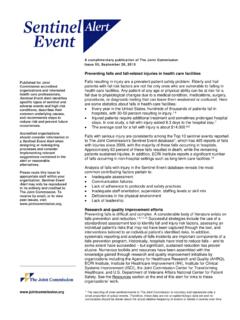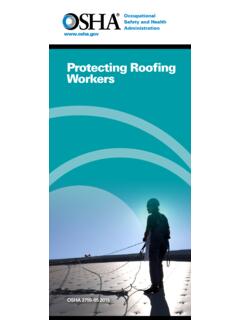Transcription of TPM Timber --A
1 ~ Timber Products Manufacturers TPM--A S S O C I A T I O N--Slips Trips & Falls 29 CFR Slips Trips & Falls OSHA maintains general industry regulations on walking/working surfaces that guard against hazards including clutter, protruding objects and wet conditions. These hazards can harm everyone in a facility, regardless of title or job responsibilities. Slips, trips, and falls cause nearly 700 fatalities per year and many more injurious accident in the workplace according to the Bureau of Labor Statistics. There are three physical factors involved in slips, trips, and falls: friction, momentum, and gravity.
2 Each one plays a role. Friction is the resistance between objects, momentum is affected by the speed and mass of an object, and gravity is the force exerted on an object by the Earth. Slips Trips & Falls Slips are a loss of balance cause by too little friction between your feet and the surface you walk or work on. Loss of traction is the leading cause of workplace slips. SLIPS Slips can be caused by wet surfaces, spills, or weather hazards like ice or snow. Slips are more likely to occur when you hurry or run, wear the wrong kind of shoes, or don t pay attention to where you re walking. Trips occur whenever your foot hits an object and you are moving with enough momentum to be thrown off TRIPS balance.
3 Trips are more likely to happen when you are in a hurry and don t pay attention to where you re going. Falls occur whenever you move too far off your center of FALLS balance. Falls account for more workplace fatalities than any other reason. Employee Training There are no formal training requirements for slips, trips, and falls. However you must train your employees to recognize and avoid unsafe conditions, which could include the hazards listed here. Training Tips Use the employee handout to explain the hazards of slips, trips and falls with the employees. Review OSHA Walking/Working Surfaces, and explain to your employees what is expected of them to prevent accidents.
4 Review ways that your employees can protect themselves from slip, trip and fall hazards. Based upon your work place, discuss how to right choice of shoe can help prevent slips, trips, and falls. Show new employees areas that might create slip, trip or fall hazards. Discuss any company programs for shoe purchase or reimbursement. Show new employees areas that might create slip, trip or fall hazards. For more information see: 29 CFR Walking/working surfaces. J~:tii! . ,\ ,, :!~!!~h~ ,~g~<aus< s of unintentional ~1lJurie~ in the United States, accounting for appr,oxlmately 8 ,9 million , isib tu the t ml rgcnc:) dcp,,rtmcnt.
5 " Slip, Trips & Falls Handout OSHA maintains general industry regulations on walking/working surfaces that guard against hazards including clutter, protruding objects and wet conditions. These hazards can harm everyone in a facility, regardless of title or job responsibilities. Slips, trips, and falls cause nearly 700 fatalities per year and many more injurious accident in the workplace according to the Bureau of Labor Statistics. Slips Slips can be caused by wet surfaces, spills, or weather hazards like ice or snow. Slips are more likely to occur when you hurry or run, wear the wrong kind of shoes, or don t pay attention to where you re walking. You can help avoid slips by following these safety precautions: Practice safe walking skills.
6 Take short steps on slippery surfaces to keep your center of balance under you and point your feet slightly outward. Clean up or report spills right away. Even minor spills can be very dangerous. Don t let grease accumulate at your work place. Be extra cautious on smooth surfaces such as newly waxed floors. Also be careful walking on loose carpeting. Trips Trips occur whenever your foot hits an object and you are moving with enough momentum to be thrown off balance. To prevent trip hazards: Make sure you can see where you are walking. Don t carry loads that you cannot see over. Keep walking and working areas well lit, especially at night. Keep the work place clean and tidy.
7 Store materials and supplies in the appropriate storage areas. Arrange furniture and office equipment so that it doesn t interfere with walkways or pedestrian traffic in your area. Properly maintain walking areas, and alert appropriate authorities regarding potential maintenance related hazards. Falls To avoid falls consider the following measures: Don t jump off landings or loading docks. Use the stairs Repair or replace stairs or handrails that are loose or broken Keep passageways and aisles clear of clutter and well lit. Wear shoes with appropriate non-slip soles. _____ Slips, Trips & Falls Sign Off Sheet The employees of _____Company Name_____, have taken part in a training session Slips, Trips & Falls.
8 The session covered: OSHA s regulations for walking/working surfaces. Slips, trips, and falls and what causes them. How to avoid slips, trips, and falls in the work place. DATE OF TRAINING: FACILITY: EMPLOYEE SIGNATURE PRINT NAME Supervisor s Signature


















